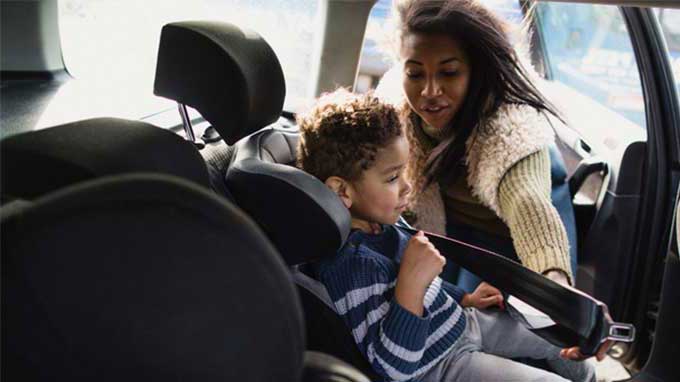Research In Action
Research In Action
Breadcrumb

Making the decision on when to transition from one type of child restraint system (CRS) to another can be challenging for parents and caregivers. The latest best practice recommendations from the American Academy of Pediatrics advise that children are kept in their current CRS until they outgrow the height or weight limitations of that seat. Some states have even legislated how long children should remain in certain restraint types, based on age.
However, considering age, height, or weight alone may overlook important developmental and behavioral factors that contribute to the effectiveness of the restraint; in other words, just because a child is physically ready to move to the next form of CRS does not necessarily mean that child is behaviorally ready.
Comparing Errors Across Restraint Types
This nuanced approach to child passenger safety, particularly related to the transition from forward-facing CRS to belt-positioning booster seat (BPB), is something I was eager to explore in my training at the University of Alabama at Birmingham and to now continue at the Center for Injury Research and Prevention at CHOP.
As part of my dissertation research I conducted a study, recently published in the Journal of Safety Research, of mothers of children 4 to 8 years old that entailed installing a forward-facing CRS or BPB into the back seat of a driving simulator, harnessing their children into the CRS or BPB, and then video-recording them during a brief simulated trip. Videos from the 50 mother-child simulated trips were systematically reviewed and child-induced errors were coded according to three categories:
- posture errors, e.g., child leaning forward so that his or her back is not touching the seat
- restraint errors, e.g., child moving seat belt behind his or her back
- “other” errors, e.g., child lifting body out of seat
Of the 50 child participants, 14 were restrained in a forward-facing CRS and were not observed to have any child-induced errors during the simulated drive. The majority of the children in the study (36, or 72%) were restrained in a BPB and were observed to have multiple error events during the simulated drives; importantly, the youngest child participants (4-year-olds, n=8) on average spent 67% of the total drive inappropriately restrained. Children ages 5 to 8 restrained in a BPB spent more than 70% of the time properly restrained/seated.
These data support a safety benefit to delaying transition from a forward-facing CRS to a booster as long as possible, as younger children may not be able to use a BPB as intended or designed to be used.
The Complexities of Child Passenger Safety
While these findings indicate that parents and caregivers should keep children in harnessed seats longer, this decision can be complex; for example, heavier, younger children may reach the engineering limitations of harnessed seats but not be mature enough to appropriately sit in a booster seat throughout a trip.
While best practice recommendations and state-specific laws should be followed, an individualized approach to child passenger safety should be taken based on a child’s physical and behavioral milestones and in conjunction with experts, such as pediatricians and certified child passenger safety technicians.
Also as part of my dissertation, I conducted a meta-analysis of caregiver-targeted child passenger safety interventions that was recently published in JAMA Network Open. I found that these interventions were effective at improving rates of CRS use; however, their effectiveness varied based on factors like setting, methodology, and if a specific demographic was targeted.
All things considered there is no “one size fits all” approach to child passenger safety; instead, a coordinated and individualized approach can ensure optimal safety for all child passengers.
Access child passenger safety videos for each stage of a child's life on CHOP's Car Seat Safety for Kids website.

